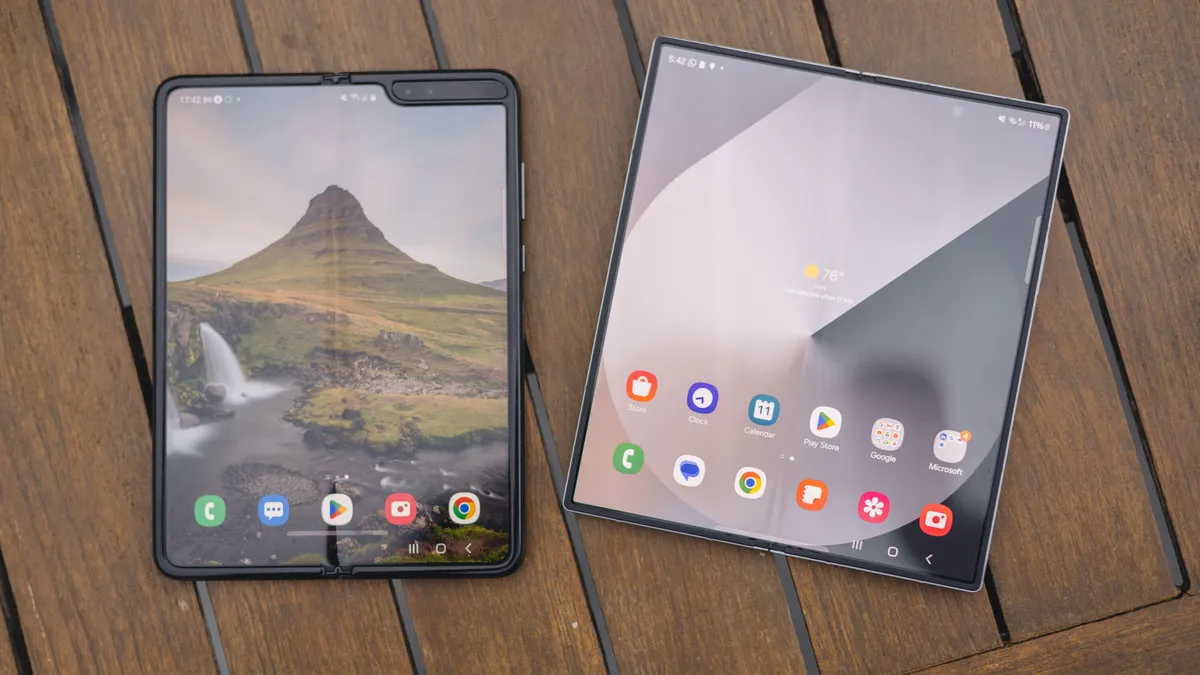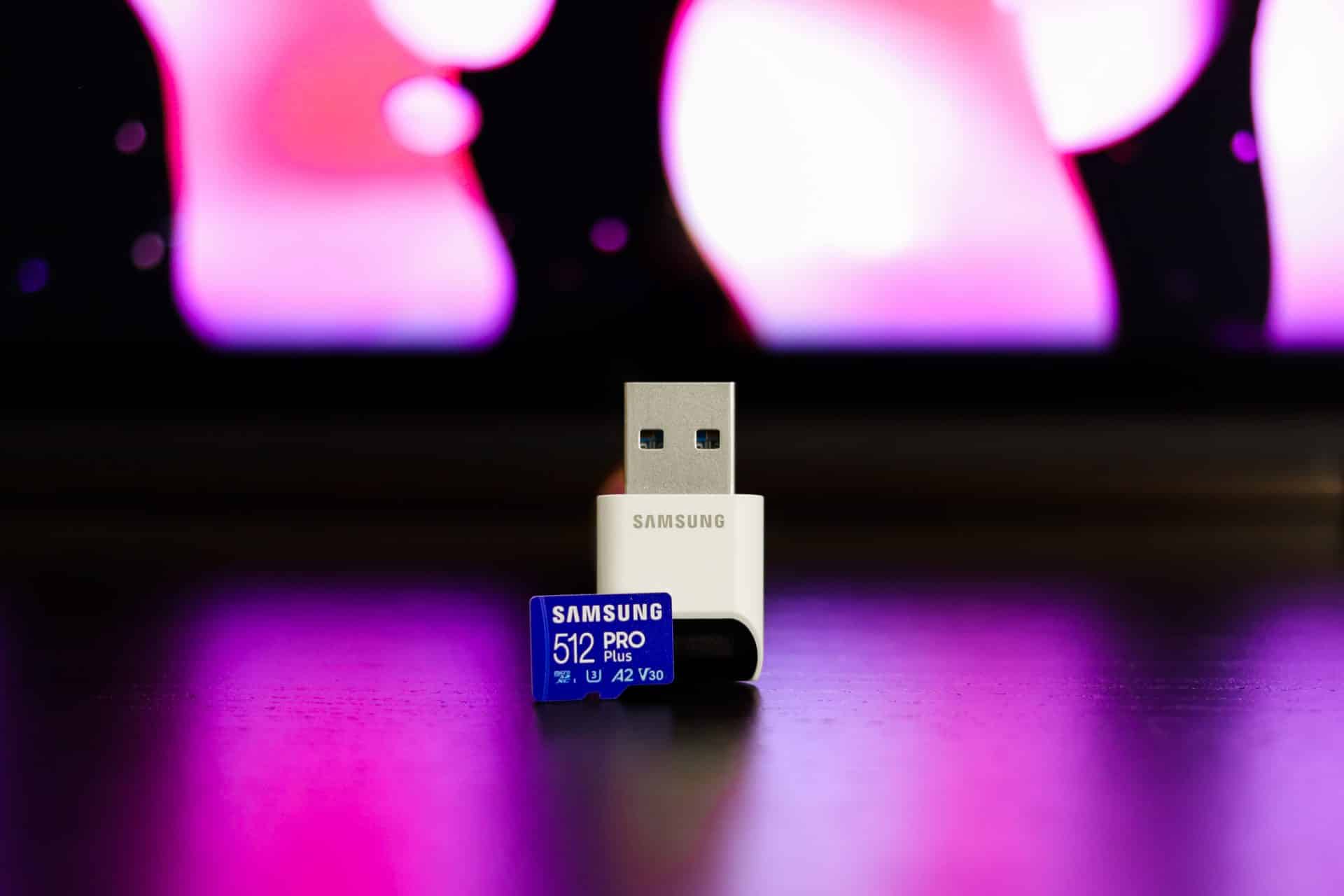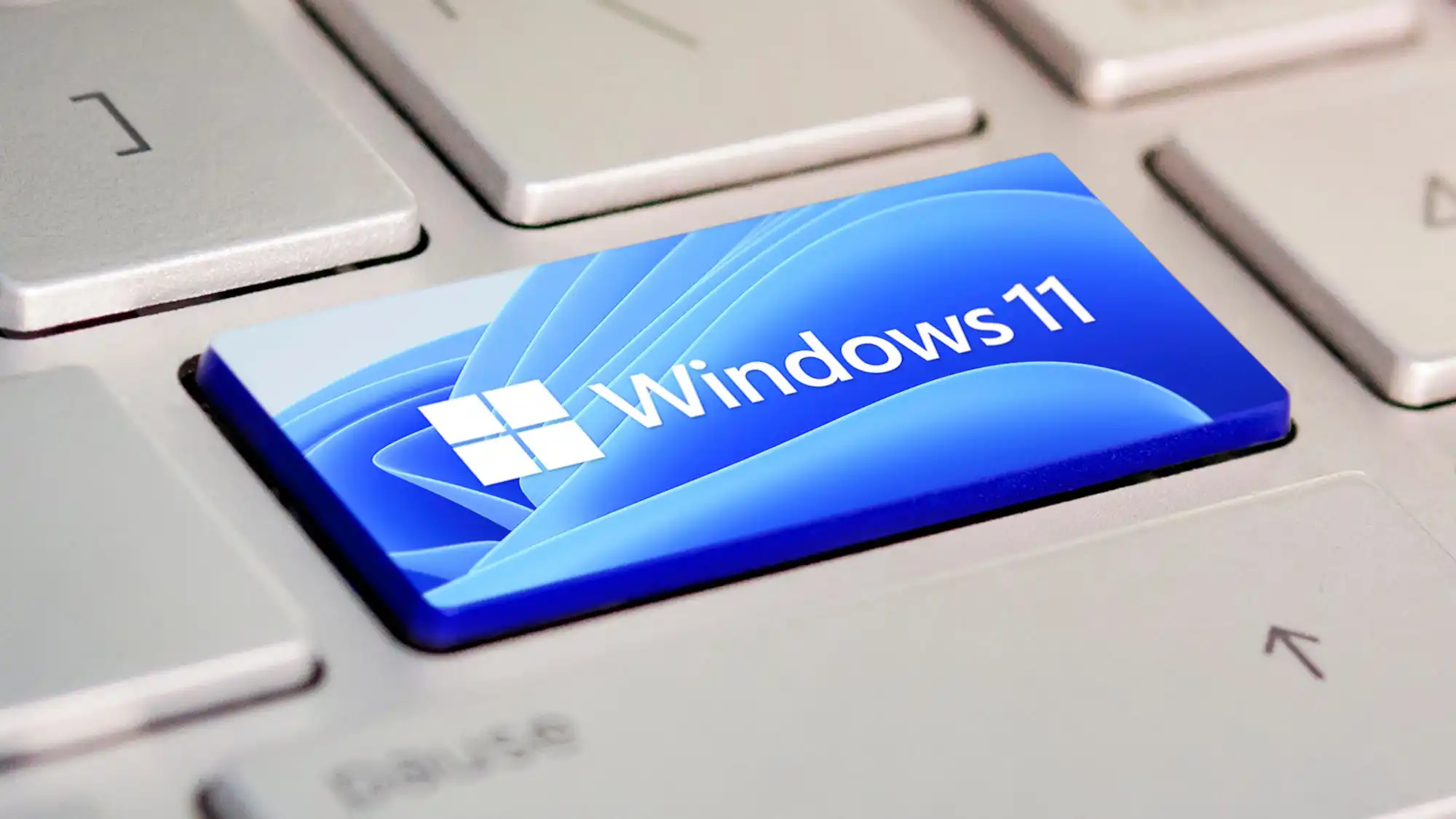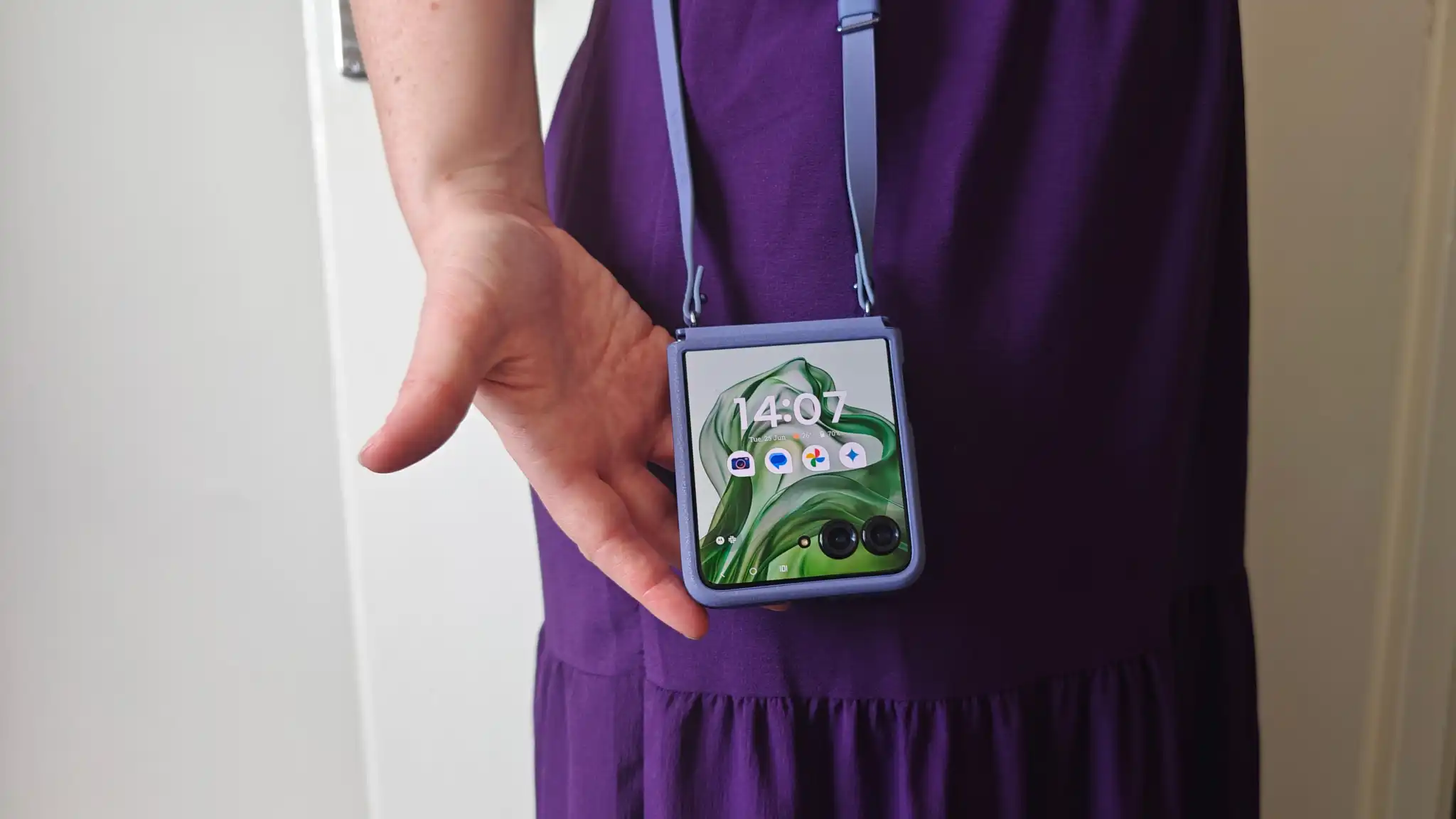I was among the first to get hold of the original Samsung Galaxy Z Fold when it went on sale in London back in 2019. Today, I got my hands on the Galaxy Z Fold 6. Five years on, the differences are huge.
It’s no surprise that today’s Fold runs the latest Snapdragon 8 Gen 3 processor, which would comfortably outstrip the OG phone on benchmarks. And, similarly, the cameras have been iterated over time. But it’s the evolution of the design that’s especially noticeable, with big changes to the cover displays and the hinge. Samsung has also phased out the screen notch over the generations.
Here’s how the phone has evolved over the years.
The hinge
The phone’s folding mechanism has been refined since 2019. The original had a sort of teardrop-shaped gap when closed, meaning each half didn’t lie flat against the other. At the time this didn’t really stand out as that odd, but when viewed against the alliteration it’s a dramatic change.

The Z Flip 6’s hinge allows each side to sit completely flat against each other, with no visible gap. It looks neater and more refined as a result. It’s also less likely that dirt, dust and debris will sneak in through the gap while it’s in your pocket.
The change that stands out most to me though is that the hinge on the most recent Fold models has resistance when you open it, allowing it to stay open at any angle, and allow it to be propped up on a table. The original Fold was either open and flat, or snapped shut. It didn’t have a halfway point and simply leaving it half closed would make it flap around pathetically.

The outer cover display on the original Fold measures 4.6 inches, with a long and thin 21:9 aspect ratio that made it look like a tiny display awkwardly lost in the rest of the phone. It was so thin that using the outer screen for anything more than checking notifications was awkward. Trying to type out long messages on it was nigh on impossible — especially if you had big thumbs.
The Z Fold 6’s outer display fills the whole outer panel of the phone, measuring a much more generous 6.3 inches. This makes it infinitely more usable as a candybar-style phone when closed, providing enough room for typing, web browsing or watching videos when it’s propped up.

It’s also brighter than the original model’s outer display and colors look more vibrant too. In short, it’s a proper phone screen, unlike the tiny slither of nonsense seen on the first one.
Notch or no notch
While the original Z Fold’s 7.3-inch interior screen was a decent size, it was spoiled by the hefty notch cut out at the top right of the display. This was there to house the front-facing cameras — much like the notches seen on many regular phones at the time — so it was a forgivable, necessary design choice.

But that notch was phased out over time, going from a punch-hole cutout for the selfie camera on the Z Fold 2 to a practically invisible under-display camera on the Z Fold 3 and beyond. While the Z Fold 6’s under-display selfie camera hasn’t really moved on since then, it’s still a vast departure from the massive notch seen on the original.
Physical design
There’s a whole host of physical changes to be seen all over the phone. The corners on the Z Fold 6 are almost perfect right angles, rather than the rounded corners of the original. The edges are squared-off too, with metal surrounds which feel a lot more sturdy than the rounded glass of the first gen — which I managed to shatter when the phone dropped to the floor.

The most noticeable change is the size and aspect ratio of the phone when closed, which now has dimensions much more akin to a regular candybar phone. The original Fold, when closed, was weirdly tall and narrow to hold, which is probably why the outer display had to be made so tiny to fit in.
Still a crease

One thing that surprised me was that the crease in the folding display was still apparent on the new model. As with all foldable phones the crease becomes more apparent if you have strong reflections on the screen — from overhead office lights, perhaps — and in darker conditions with bright content on the screen the crease becomes almost invisible. But it’s definitely still there. I’d hoped to see more of an evolution here in the five years we’ve had flexible screens.
The changes between the Galaxy Z Fold 5 and the new Z Fold 6 might not be a huge evolution, but when you look back at the first-gen model it’s clear to see how the product has been refined over the years and how the folding and
Samsung Galaxy Z Fold 6 Specs vs. Samsung Galaxy Z Fold
| Samsung Galaxy Fold 6 | Samsung Galaxy Fold | |
|---|---|---|
| Cover display size, tech, resolution, refresh rate | 6.3-inch AMOLED; 2,376×968 pixels; 1-120Hz variable refresh rate | 4.6-inch AMOLED; 1,680×720 pixels; 60Hz refresh rate |
| Internal display size, tech, resolution, refresh rate | 7.6-inch AMOLED; 2,160×1,856 pixels;1-120Hz variable refresh rate | 7.3-inch AMOLED; 2,152×1,536 pixels; 60Hz refresh rate |
| Pixel density | Cover: 410 ppi; Internal: 374 ppi | Cover: 397 ppi; Internal: 362ppi |
| Dimensions (inches) | Open: 6.04×5.21×0.22 in; Closed: 6.04×2.68×0.48 in | Open: 6.3×4.6×0.3 in; Closed: 6.3×2.5×0.6 in |
| Dimensions (millimeters) | Open: 153.5×132.5×5.6mm; Closed: 153.5×68.1×12.1mm | Open: 117.9x161x6.9mm ~ 7.6mm; Closed: 62.8x161x15.7mm ~ 17.1mm |
| Weight (grams, ounces) | 239 g (8.43 oz) | 276 g (9.7 oz) |
| Mobile software | Android 14 | Android 9 |
| Camera | 50-megapixel (wide), 12-megapixel (ultrawide), 10-megapixel (3x telephoto) | 12-megapixel (wide), 16-megapixel (ultrawide), 12-megapixel (telephoto) |
| Front-facing camera | 4-megapixel (inner under-display selfie); 10-megapixel (cover selfie) | 10-megapixel (cover selfie); 10-megapixel & 8-megapixel (inner selfie) |
| Video capture | TBD | 4K |
| Processor | Snapdragon 8 Gen 3 | Qualcomm Snapdragon 855 |
| RAM/storage | 12GB + 256GB, 512GB, 1TB | 12GB + 512GB |
| Expandable storage | None | None |
| Battery | 4,400 mAh | 4,380mAh |
| Fingerprint sensor | Side | Side |
| Connector | USB-C | USB-C |
| Headphone jack | None | None |
| Special features | IP48 rating, 25W wired charging, wireless charging + powershare, 3x optical zoom (up to 10x digital and 30x Space Zoom with AI Super Resolution tech) | Foldable display, wireless charging, fast charging |
| US price starts at | $1,900 (256GB) | $1,980 (512GB) |
| UK price starts at | TBD | £2,000 |
| Australia price starts at | TBD | AU$2,950 |




